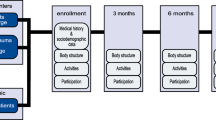Abstract
Background and purpose
The effectiveness of therapeutic interventions in acute stroke trials is traditionally measured with the modified Rankin scale (mRs) and the Barthel index (BI). The mRs is a global disability scale divided into six steps from total independence to total dependence. The BI assesses ten basal activities of daily living, of which eight assess level of dependence (bathing, grooming, using stairs, dressing, feeding, toilet use, transfers and walking). The aim of this study was to investigate the relationship between the mRs and the total scores and item-scores of the BI.
Methods
During a period of 3 months mRs and BI scores were collected from two multicentre randomised, placebo-controlled trials with lubeluzole (515 and 519 patients). In each patient we compared the mRs grades with the total BI score and the scores on the ten subitems.
Results
For both trials there was extensive overlap of BI scores between mRs grades and a wide range in BI scores among patients with mRs grades 3 and 4. We also found discrepancies between the BI item-scores and mRs grades. About 40% of patients with mRs grades 1 (able to carry out all usual activities) and 2 (able to look after own affairs without assistance) were not independent on at least one activity of the BI. In both studies, about 30% of the patients needed help or supervision for walking, although they were classified as mRs 3 (requiring some help but able to walk without assistance).
Conclusions
Investigators in stroke trials use the mRs as a subjective global disability scale, and they do not strictly take into account limitations in performing specific basal activities of daily living, as assessed by the BI, to assign mRs grades.
Similar content being viewed by others
References
Berge E, Barer D (2002) Could stroke trials be missing important treatment effects? Cerebrovasc Dis 13(1):73–5
Brott T, Adams HP Jr, Olinger CP, Marler JR, Barsan WG, Biller J, Spilker J, Holleran R, Eberle R, Hertzberg V (1989) Measurements of acute cerebral infarction: a clinical examination scale. Stroke 20(7):864–70
D'Olhaberriague L, Litvan I, Mitsias P, Mansbach HH (1996) A reappraisal of reliability and validity studies in stroke. Stroke 27(12):2331–336
de Haan R, Limburg M, Bossuyt P, van der Meulen J, Aaronson N (1995) The clinical meaning of Rankin ‘handicap–grades after stroke. Stroke 26(11):2027–030
de Haan R, Limburg M, Schuling J, Broeshart J, Jonkers L, van Zuylen P (1993) Clinimetric evaluation of the Barthel Index, a measure of limitations in daily activities. Ned Tijdschr Geneeskd 137(18):917–21
Dennis M, Wellwood I, ORourke S, MacHale S, Warlow C (1997) How reliable are simple questions in assessing outcome after stroke? Cerebrovasc Dis 7(1):19–1
Dennis M, Wellwood I, Warlow C (1997) Are simple questions a valid measure of outcome after stroke? Cerebrovasc Dis 7(1):22–7
Diener H (1998) Multinational randomised controlled trial of lubeluzole in acute ischaemic stroke. Cerebrovasc Dis 8(3):172–81
Duncan P, Jorgensen HS, Wade DT (2000) Outcome measures in acute stroke trials: a systematic review and some recommendations to improve practice. Stroke 31(6):1429–438
Grotta J (1997) Lubeluzole treatment of acute ischemic stroke. The US and Canadian Lubeluzole Ischemic Stroke Study Group. Stroke 28(12):2338–346
Hantson L, De Weerdt W, De Keyser J, Diener HC, Franke C, Palm R, Van Orshoven M, Schoonderwalt H, De Klippel N, Herroelen L (1994) The European Stroke Scale. Stroke 25(11):2215–219
Kelly-Hayes M, Robertson JT, Broderick JP, Duncan PW, Hershey LA, Roth EJ, Thies WH, Trombly CA (1998) The American Heart Association Stroke Outcome Classification. Stroke 29(6):1274–280
Lindley RI, Waddell F, Livingstone M, Sandercock P, Dennis MS, Slattery J, Smith B,Warlow C (1994) Can simple questions assess outcome after stroke? Cerebrovasc Dis 4(4):314–24
Mahoney F, Barthel D (1965) Functional evaluation: the Barthel index. Md Med J 14:56–1
Rankin J (1957) Cerebral vascular accidents in patients over the age of 60. II. Prognosis. Scott Med J 2(5):200–15
Roberts L, Counsell C (1998) Assessment of Clinical Outcomes in Acute Stroke Trials. Stroke 29(5):986–91
Sulter G, Steen C, de Keyser J (1999) Use of the Barthel index and modified Rankin scale in acute stroke trials. Stroke 30(8):1538–541
van Swieten JC, Koudstaal PJ, Visser MC, Schouten HJ, van Gijn J (1988) Interobserver agreement for the assessment of handicap in stroke patients. Stroke 19(5):604–07
Wilson JTL, Hareendran A, Grant M, Baird T, Schulz UGR, Muir KW, Bone I (2002) Improving the Assessment of Outcomes in Stroke: Use of a Structured Interview to Assign Grades on the Modified Rankin Scale. Stroke 33(9):2243–246
Wilson JTL, Hareendran A, Hendry A, Potter J, Bone I, Muir KW (2005) Reliability of the Modified Rankin Scale Across Multiple Raters: Benefits of a Structured Interview. Stroke 36(4):777–81
Wolfe CD, Taub NA,Woodrow EJ, Burney PG (1991) Assessment of scales of disability and handicap for stroke patients. Stroke 22(10):1242–244
World Health Organisation (1980) International Classification of Impairments, Disabilities and Handicaps. Geneva, Switzerland.World Health Organisation
Author information
Authors and Affiliations
Corresponding author
Rights and permissions
About this article
Cite this article
Uyttenboogaart, M., Luijckx, GJ., Vroomen, P.C.A.J. et al. Measuring disability in stroke: relationship between the modified Rankin scale and the Barthel index. J Neurol 254, 1113–1117 (2007). https://doi.org/10.1007/s00415-007-0646-0
Received:
Revised:
Accepted:
Published:
Issue Date:
DOI: https://doi.org/10.1007/s00415-007-0646-0




